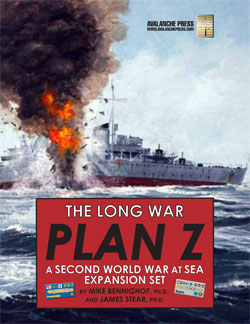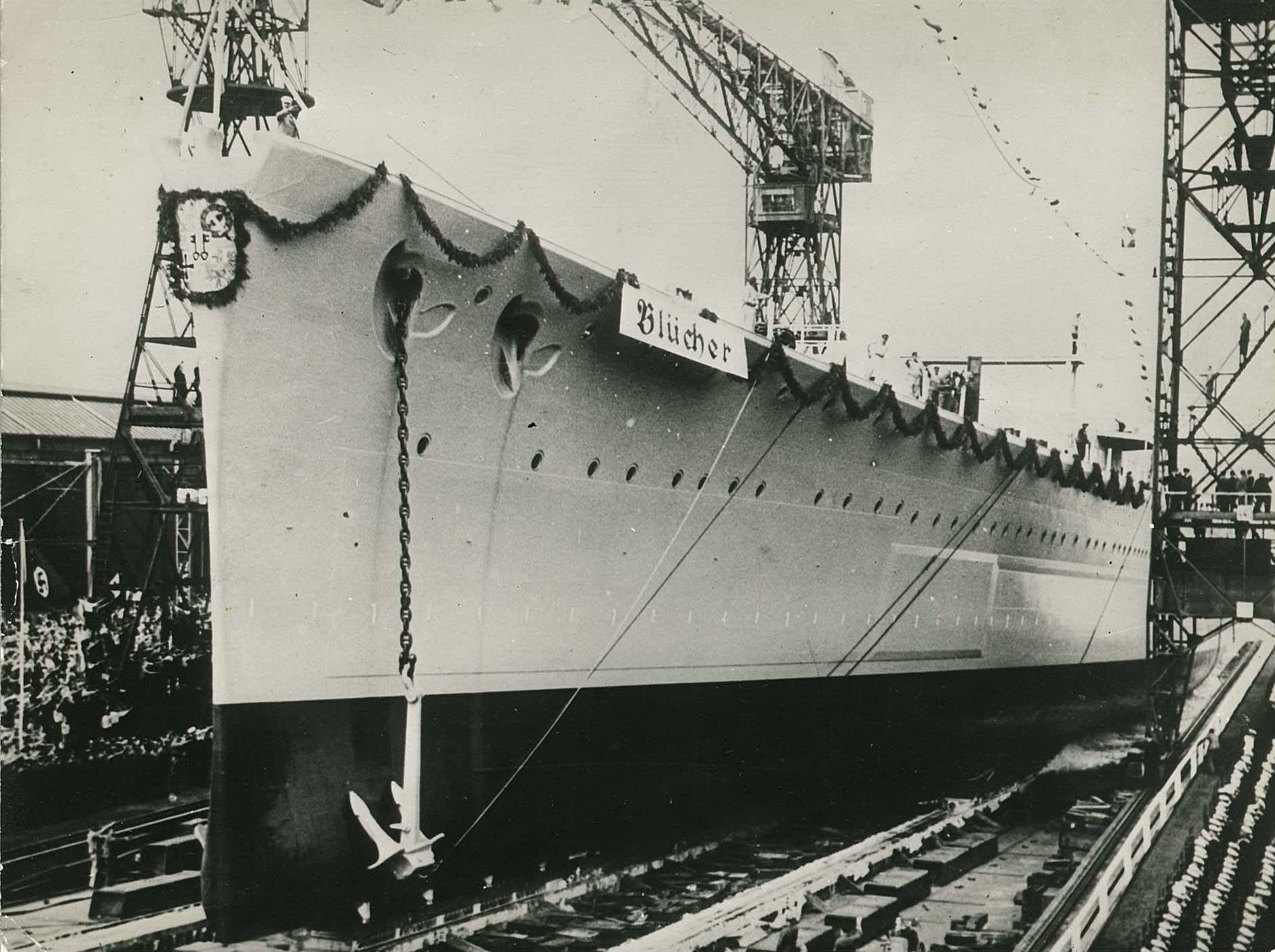Plan Z:
German Battle Cruisers
by Mike Bennighof, Ph.D.
October 2021
 The German Kriegsmarine’s grandiose Plan Z called for a huge surface fleet including a dozen new long-range armored cruisers for commerce raiding, a ship design known as Cruiser P. By the time the German Warship Construction Office completed their sketches the ship had reached 25,000 tons, making her main armament of six 11-inch guns seem paltry for such a large ship. The next requested change, of course, was for more powerful guns. The German Kriegsmarine’s grandiose Plan Z called for a huge surface fleet including a dozen new long-range armored cruisers for commerce raiding, a ship design known as Cruiser P. By the time the German Warship Construction Office completed their sketches the ship had reached 25,000 tons, making her main armament of six 11-inch guns seem paltry for such a large ship. The next requested change, of course, was for more powerful guns.
The battle cruiser concept joined Plan Z at a very late stage, after Adolf Hitler had already given approval to the program and granted the Kriegsmarine the budgetary priority to get these ships built. Very fast, very-long-range ships with battleship guns would force the British to create large convoys and add battleships to their escorts even at a great distance from European waters. In theory, these concentrated convoys could then be attacked by the new German surface fleet.
Cruiser P, the bloated pocket battleship design from which the new battle cruiser derived, could have performed that mission just as easily, especially if the huge cruisers operated in packs of two or three ships. But Erich Raeder, the Kriegsmarine’s long-time chief, seems to have been intent on re-creating his own vision of a long-range, high-speed High Seas Fleet. Where the Imperial Navy’s High Seas Fleet was trapped in the North Sea by its short range (and some inconvenient geography), Raeder’s version would roam the entire North Atlantic and beyond.
 Raeder had never liked the Cruiser P concept, not least because it grew out of the philosophy of his despised predecessor, Admiral Hans Zenker. But battle cruisers fit his vision; as a young officer, Raeder had been chief of staff of the High Seas Fleet’s battle cruiser group. Replacing three of the armored cruisers with battle cruisers would bring his new fleet closer in organization to the old High Seas Fleet of his youth. Raeder had never liked the Cruiser P concept, not least because it grew out of the philosophy of his despised predecessor, Admiral Hans Zenker. But battle cruisers fit his vision; as a young officer, Raeder had been chief of staff of the High Seas Fleet’s battle cruiser group. Replacing three of the armored cruisers with battle cruisers would bring his new fleet closer in organization to the old High Seas Fleet of his youth.
The new ship, labelled Battle Cruiser O (taking a letter in the battleship sequence), received approval in January 1939, before the design had been finalized though design proposals for such a ship had been drafted starting in 1937. Three ships were ordered in July and August 1939, with contracts for three Cruiser P ships altered to the new design instead.
Battle Cruiser O would carry six 15-inch guns in three dual turrets (the same weapon fitted in the Bismarck class battleships), six 5.9-inch (150mm) secondary guns, and eight 105mm (4.1-inch) heavy anti-aircraft guns – Nazi Germany did not develop a dual-purpose secondary weapon until very late in World War II, greatly hampering their heavy warships’ anti-aircraft defense. The design sketches show very few light anti-aircraft guns but the huge hull obviously had space to add many more. She would also carry six torpedo tubes.
And she would be a huge ship: 256 meters long, longer than the battleship Bismarck though not matching the massive H-class battleships. Likely due to her rushed design phase, Battle Cruiser O had a very conventional hull form, with neither the bulbous bow pioneered in large German liners or the transom stern of Cruiser P. She would displace 32,000 tons; Cruiser P, by comparison, had a displacement of 25,000 tons and a length of 235 meters. Like the other ships of Plan Z, she would be very fast, with a designed speed of 33.4 knots (though Raeder had demanded 34). And she would have great range, though less than some of the other Plan Z designs: 14,000 nautical miles.
The quest for speed dictated the long, narrow hull and also required a massive power plant. Cruiser P had a diesel power plant that produced 165,000 horsepower (almost identical to that of the H-Class battleships), the most powerful marine engines built in Germany up until that time. Battle Cruiser O would need even more power.
An even larger diesel power plant, assuming one could even be built, would require a wider ship which in turn would make her even longer (to maintain the slender length-to-beam ratio needed for high speed). With that approach deemed unacceptable, the design team went with the hybrid power plant common in late-generation German cruisers.
Battle Cruiser O would have diesel power rooms amidships, eight huge diesel engines each producing 14,500 horsepower (the H Class power plant had 12 engines, each rated for 13,750 horsepower). Those would drive the two outermost of the ship’s three propeller shafts, good for 27 knots by themselves.
Aft of the diesel rooms would be a huge turbine driving the central shaft, with four high-pressure boilers and rated for 60,000 horsepower (giving the ship 176,000 horsepower total). The turbine would only kick in when the ship needed a burst of speed, to conserve its fuel, and with both power plants in operation Battle Cruiser O was expected to make 33.4 knots. To speed construction, the huge turbines already ordered for Aircraft Carrier B, the sister to Graf Zeppelin, would be used in the new battle cruisers.

Deutsche Werke in Kiel would have built Battle Cruiser O.
To compensate for the weight of the massive power plant, Battle Cruiser O would have minimal protection. The secondary (150mm) guns would be mounted in unarmored gunhouses (the same mounting used in destroyers) rather than the armored turrets common to other German heavy warships. Though the 15-inch turrets bore a superficial similarity to those of Bismarck, they had much less armor protection as did the underlying armored barbette structure.
She would have a slightly thicker armored belt than Cruiser P but a thinner armored deck; she would be proof against the guns of enemy cruisers but have no meaningful protection against battleship guns, and would have been almost helpless against air attack as well. While she had reasonable internal subdivision fore and aft, those huge rooms amidships for the diesel engines would have made her incredibly vulnerable to a mine or torpedo strike there.
Three ships were ordered in the summer of 1939, replacing three of the promised Cruiser P contracts – Cruiser P was never formally ordered, so Battle Cruiser O represented a higher form of vaporware. None were actually begun beyond the gathering of some material, and none of the contracts appear to have been actually cancelled. Other projects took their place, and the ships simply faded away.
Like most of the other ships of Plan Z, Battle Cruiser O was hurriedly designed and poorly thought out. Her mission was based on a fanciful notion of a future naval war that took little account of reality even as understood in 1939. She would have been enormously expensive and enormously vulnerable to air, surface and submarine attack. But at least she would have been enormous, fulfilling an emotional need for the Kriegsmarine and its commander.
Second World War at Sea: Plan Z, not hampered by the bounds of reality, includes all three of the proposed battle cruisers.
Click here to order Second World War at Sea: Plan Z (book edition) right now.
Sign up for our newsletter right here. Your info will never be sold or transferred; we'll just use it to update you on new games and new offers.
Mike Bennighof is president of Avalanche Press and holds a doctorate in history from Emory University. A Fulbright Scholar and NASA Journalist in Space finalist, he has a whole passel of books, games and articles on historical subjects.
He lives in Birmingham, Alabama with his wife, three children and his dog, Leopold. Leopold likes having a puppy to play with.
|
